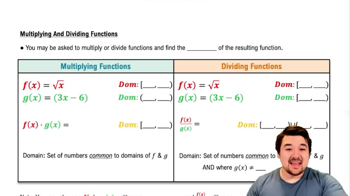Composition of polynomials
Let ƒ be an nth-degree polynomial and let g be an mth-degree polynomial.
What is the degree of the following polynomials?
ƒ o g
 Verified step by step guidance
Verified step by step guidance Verified video answer for a similar problem:
Verified video answer for a similar problem:



 5:56m
5:56mMaster Adding & Subtracting Functions with a bite sized video explanation from Patrick
Start learning